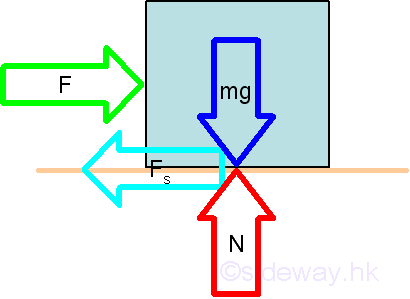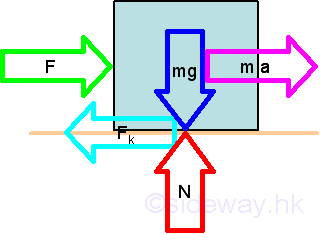Mechanics: Statics
Statics is the study of forces which act on a rigid body with no change
in momentum occur and is concerned with the static equilibrium state of the rigid body under the
action of forces as stated in Newton's First and Third Laws. But static
mechanics is mainly deal
with problems of statics of which rigid bodys are always at rest.
Force
By Newton's Second Law, the accelarion of an object is directly proportional to
the applied force and inversely proportional to the object mass. Applied force is
measured as 1 Newton when the applied force cause an object of mass 1 kg to
accelerae at 1m/s and can be expressed F=ma. As the object is also accelerated
according to the direction of the applied force, force is a vector quantity. But, in
fact, the nature of a force is derived from the resultant of interaction between two objects.
Idealizations
Idealizations are techniques used to simplify the application of theory in
problem modeling. They are
-
Particle is a point mass and
its size can be neglected
-
Rigid Body is
one single object formed by a combination of particles in which all
particles remain at a fixed distance from one another and are assumed to be rigid
under applied forces.
-
Concentrated Force is a mathematical representation of the effect of forces
acting on a rigid body by assuming a single force acts at a point on the
object along a single line of force in space.
Types of Force
The most common types of forces are
-
Gravity
force: Gravity force is the volume force dealing with the Newton's law of
gravitational attraction. The earth exerts an gravitational force of weight
downward on every objects on its surface. Gravity force is also called body
force or weight of an object.
 and
and

-
Surface Force: Surface force is force applied to the surface of an object.
-
Applied Force: Applied force is a surface force acting upon an object. The
total force applied by a surface force can be deposited to normal force and
pallarel force with respect to the surface of the object.
-
Normal Force: Normal Force is force applied to the suface of an object
perpendicularly. It can be a compression force to squash an object or an
extension force to strench an object.
-
Friction: Friction is
the force applied to the surface of an object parallelly by a
surface due to the interaction between two surfaces. There are two types of friction.
-
Force deals with two at
rest object surfaces relative to each other is static friction. Static friction
force is the force resisting object motion. Before motion begins, the static
friction force is of equal magnitude and opposite direction of the net applied
force. The maximum
possible static friction between two surfaces is the product of the normal force
between two surfaces and the coefficient of static friction of the two surfaces
involved.


-
Force deals with two moving object
surfaces relative to each other is kinetic friction. The direction of friction
force is opposite to the motion. When motion begins, the kinetic friction force can be approximated
by the product of the normal force between two surfaces and the coefficient of
kinetic friction of the two surfaces involved. The kinetic friction force acts
as the opposite force to retard the motion.


-
Tension: Tension is force exerted on a rope
or a cable when pulling on. The applied force is transmitted from one end
to the other along the rope. It is similar to the extension force of
stretching an object.
 Sideway
BICK BLOG from Sideway
Sideway
BICK BLOG from Sideway and
and






